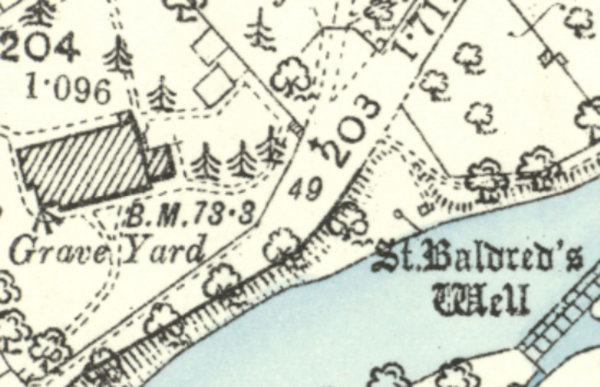 |
Dedication: Saint Baldred Location: East Linton Coordinates: 55.991427N, -2.6538400W Grid reference: NT593778 Heritage designation: none |
 |
Dedication: Saint Baldred Location: East Linton Coordinates: 55.991427N, -2.6538400W Grid reference: NT593778 Heritage designation: none |
St Baldred was a Northumbrian hermit who lived during the 8th century. He was active in the area around East Linton, and he is thought to have founded a monastery at Tyninghame, only two miles away from East Linton and his surviving holy well. He almost certainly founded Prestonkirk's parish church, which bears his dedication. Baldred has often been described as the "Apostle of the Lothians", and he was quite popular in the area after his death in the mid 700s.
St Baldred's Well is probably roughly the same age as the parish church, which is located nearby; water from the spring would almost certainly have been used for baptisms throughout the medieval period. The earliest reference that I have been able to find to this site dates from 1796, and was made in the Univerſal Dictionary of Knowledge, volume 3:
|
BALDRID'S WELL, and | } | and places in the pariſh of Preſton-Kirk, in Haddingtonſhire; ſo named from St Baldrid, the tutelar Saint of the pariſh, to whom a church, built on the ſite of the preſent pariſh church, was dedicated to above 1000 years ago. |
Presumably, "Baldrid's Whill" refers to St Baldred's Whirl, which, according to the Ordnance Survey Name-Book of 1853, was a kind of pool in the River Tyne (which could, quite possibly, have been used for bathing or baptisms). Nicholas Carlisle, in 1813, described St Baldred's Whirl as "a Pool or Eddy in the Tyne", in A Topographical Dictionary of Scotland.
The exact age of the stone trough that the spring fills is not certain, but it is definitely at least a hundred or so years old. J.M. Mackinlay, in an informative essay entitled Some Notes on St Baldred's Country, which was published in 1894 as part of volume 28 of The Proceedings of the Society of Antiquaries of Scotland, appears to have described the very same trough:
|
Across the highway from the graveyard is St Baldred's Well, on the slope, two or three yards above the Tyne. The water trickles out from the bank and falls into a trough, formed of four stones. The enclosed space measures about 2 feet by 15 inches, and the depth is over a foot. The bottom is covered with sand and gravel. The water is beautifully clear and cold. |
Today, St Baldred's Well is reportedly in good condition, and the spring still produces a plentiful supply of water.
|
Access: A set of steps, with a handrail, lead down to the well from the side of the road. |
Images:
Old OS maps are reproduced with the permission of the National Library of Scotland
Copyright 2025 britishholywells.co.uk